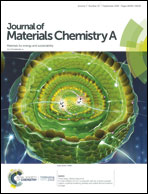Manipulating H-bonds in glassy dipolar polymers as a new strategy for high energy storage capacitors with high pulse discharge efficiency†
Abstract
Polymer dielectrics with high energy density (Ue) and low energy loss (Ul) under elevated electric fields and temperatures are in urgent demand for next-generation energy storage devices, e.g., high-pulse film capacitors. To overcome their long-standing tradeoff between high Ue and low Ul, a series of flexible glassy poly(styrene-methyl methacrylate-methallyl alcohol) (P(St-MMA-MAA)) terpolymers with promising dielectric and physical properties, including improved tunable permittivity (3–6 range), thermal stability, and processability, are investigated and compared to the commercially available state-of-the-art polymer dielectric, i.e., biaxially oriented polypropylene. The benzyl groups of the low-polarity polystyrene matrix suppressed the aggregation of polar units under high energy fields, i.e., diminishing the aggregation caused energy loss in the capacitive terpolymers. The hydroxyl groups on MAA units are designed to establish H-bonds between hydroxyl and ester groups, which favor the enhancement of glass transition temperature, dielectric constant, Young's modulus, and breakdown strength of polymers. As a result, a discharge energy density of 14.5 J cm−3 with a high efficiency of 93% at 700 MV m−1 is achieved. This work demonstrates that dispersing isolated dipoles into a low-polarity polymer matrix with high glass transition temperature is an effective strategy for suppressing the energy loss induced by the orientation of aggregated dipoles and creates a new avenue for high-energy and low-loss flexible capacitors.



 Please wait while we load your content...
Please wait while we load your content...